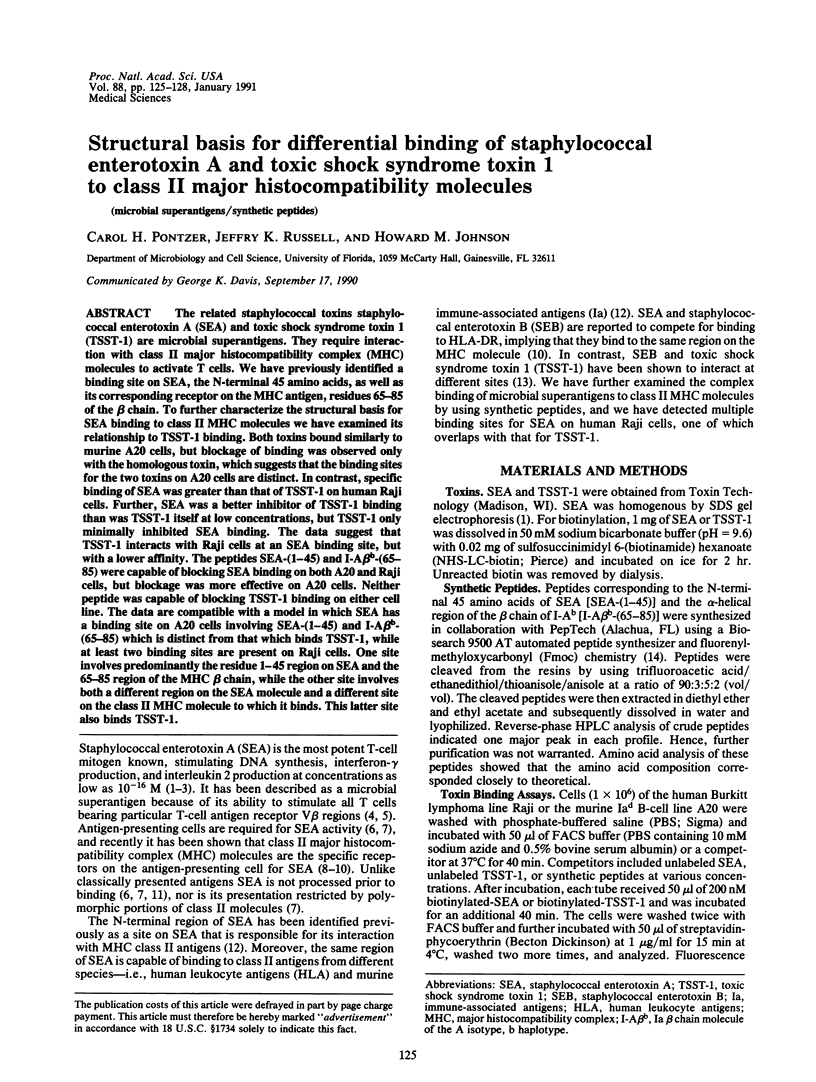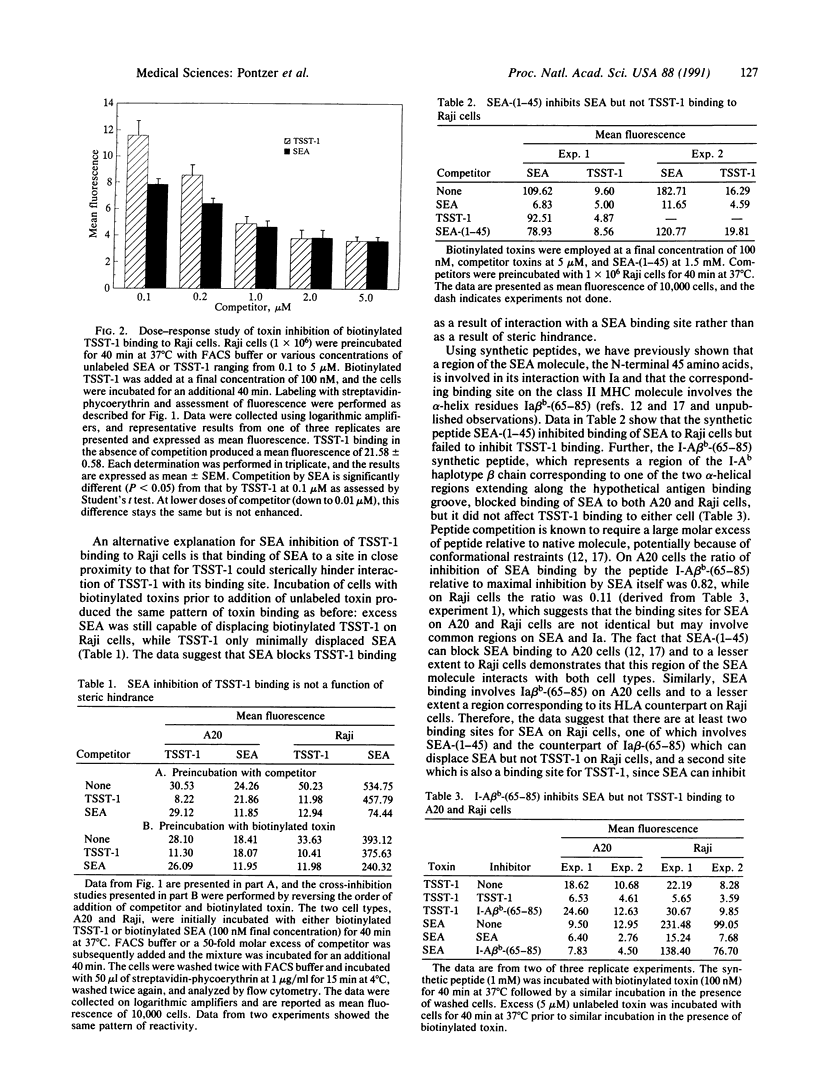Abstract
The related staphylococcal toxins staphylococcal enterotoxin A (SEA) and toxic shock syndrome toxin 1 (TSST-1) are microbial superantigens. They require interaction with class II major histocompatibility complex (MHC) molecules to activate T cells. We have previously identified a binding site on SEA, the N-terminal 45 amino acids, as well as its corresponding receptor on the MHC antigen, residues 65-85 of the beta chain. To further characterize the structural basis for SEA binding to class II MHC molecules we have examined its relationship to TSST-1 binding. Both toxins bound similarly to murine A20 cells, but blockage of binding was observed only with the homologous toxin, which suggests that the binding sites for the two toxins on A20 cells are distinct. In contrast, specific binding of SEA was greater than that of TSST-1 on human Raji cells. Further, SEA was a better inhibitor of TSST-1 binding than was TSST-1 itself at low concentrations, but TSST-1 only minimally inhibited SEA binding. The data suggest that TSST-1 interacts with Raji cells at an SEA binding site, but with a lower affinity. The peptides SEA-(1-45) and I-A beta b-(65-85) were capable of blocking SEA binding on both A20 and Raji cells, but blockage was more effective on A20 cells. Neither peptide was capable of blocking TSST-1 binding on either cell line. The data are compatible with a model in which SEA has a binding site on A20 cells involving SEA-(1-45) and I-A beta b-(65-85) which is distinct from that which binds TSST-1, while at least two binding sites are present on Raji cells. One site involves predominantly the residue 1-45 region on SEA and the 65-85 region of the MHC beta chain, while the other site involves both a different region on the SEA molecule and a different site on the class II MHC molecule to which it binds. This latter site also binds TSST-1.
Full text
PDF



Selected References
These references are in PubMed. This may not be the complete list of references from this article.
- Carlsson R., Fischer H., Sjögren H. O. Binding of staphylococcal enterotoxin A to accessory cells is a requirement for its ability to activate human T cells. J Immunol. 1988 Apr 15;140(8):2484–2488. [PubMed] [Google Scholar]
- Carlsson R., Sjögren H. O. Kinetics of IL-2 and interferon-gamma production, expression of IL-2 receptors, and cell proliferation in human mononuclear cells exposed to staphylococcal enterotoxin A. Cell Immunol. 1985 Nov;96(1):175–183. doi: 10.1016/0008-8749(85)90349-1. [DOI] [PubMed] [Google Scholar]
- Chang C. D., Meienhofer J. Solid-phase peptide synthesis using mild base cleavage of N alpha-fluorenylmethyloxycarbonylamino acids, exemplified by a synthesis of dihydrosomatostatin. Int J Pept Protein Res. 1978 Mar;11(3):246–249. doi: 10.1111/j.1399-3011.1978.tb02845.x. [DOI] [PubMed] [Google Scholar]
- Fischer H., Dohlsten M., Lindvall M., Sjögren H. O., Carlsson R. Binding of staphylococcal enterotoxin A to HLA-DR on B cell lines. J Immunol. 1989 May 1;142(9):3151–3157. [PubMed] [Google Scholar]
- Fleischer B., Schrezenmeier H. T cell stimulation by staphylococcal enterotoxins. Clonally variable response and requirement for major histocompatibility complex class II molecules on accessory or target cells. J Exp Med. 1988 May 1;167(5):1697–1707. doi: 10.1084/jem.167.5.1697. [DOI] [PMC free article] [PubMed] [Google Scholar]
- Fraser J. D. High-affinity binding of staphylococcal enterotoxins A and B to HLA-DR. Nature. 1989 May 18;339(6221):221–223. doi: 10.1038/339221a0. [DOI] [PubMed] [Google Scholar]
- Janeway C. A., Jr, Yagi J., Conrad P. J., Katz M. E., Jones B., Vroegop S., Buxser S. T-cell responses to Mls and to bacterial proteins that mimic its behavior. Immunol Rev. 1989 Feb;107:61–88. doi: 10.1111/j.1600-065x.1989.tb00003.x. [DOI] [PubMed] [Google Scholar]
- Johnson H. M., Magazine H. I. Potent mitogenic activity of staphylococcal enterotoxin A requires induction of interleukin 2. Int Arch Allergy Appl Immunol. 1988;87(1):87–90. doi: 10.1159/000234654. [DOI] [PubMed] [Google Scholar]
- Langford M. P., Stanton G. J., Johnson H. M. Biological effects of staphylococcal enterotoxin A on human peripheral lymphocytes. Infect Immun. 1978 Oct;22(1):62–68. doi: 10.1128/iai.22.1.62-68.1978. [DOI] [PMC free article] [PubMed] [Google Scholar]
- Merryman P., Silver J., Gregersen P. K., Solomon G., Winchester R. A novel association of DQ alpha and DQ beta genes in the DRw10 haplotype. Determination of a DQw1 specificity by the DQ beta-chain. J Immunol. 1989 Sep 15;143(6):2068–2073. [PubMed] [Google Scholar]
- Mollick J. A., Cook R. G., Rich R. R. Class II MHC molecules are specific receptors for staphylococcus enterotoxin A. Science. 1989 May 19;244(4906):817–820. doi: 10.1126/science.2658055. [DOI] [PubMed] [Google Scholar]
- Pontzer C. H., Russell J. K., Johnson H. M. Localization of an immune functional site on staphylococcal enterotoxin A using the synthetic peptide approach. J Immunol. 1989 Jul 1;143(1):280–284. [PubMed] [Google Scholar]
- Russell J. K., Pontzer C. H., Johnson H. M. A positive feedback loop for staphylococcal enterotoxin-A-stimulated IFN-gamma production requires macrophage immune-associated antigen upregulation. Int Arch Allergy Appl Immunol. 1989;90(3):219–223. doi: 10.1159/000235028. [DOI] [PubMed] [Google Scholar]
- Russell J. K., Pontzer C. H., Johnson H. M. The I-A beta b region (65-85) is a binding site for the superantigen, staphylococcal enterotoxin A. Biochem Biophys Res Commun. 1990 Apr 30;168(2):696–701. doi: 10.1016/0006-291x(90)92377-c. [DOI] [PubMed] [Google Scholar]
- Scholl P. R., Diez A., Geha R. S. Staphylococcal enterotoxin B and toxic shock syndrome toxin-1 bind to distinct sites on HLA-DR and HLA-DQ molecules. J Immunol. 1989 Oct 15;143(8):2583–2588. [PubMed] [Google Scholar]
- Sette A., Buus S., Colon S., Miles C., Grey H. M. Structural analysis of peptides capable of binding to more than one Ia antigen. J Immunol. 1989 Jan 1;142(1):35–40. [PubMed] [Google Scholar]
- White J., Herman A., Pullen A. M., Kubo R., Kappler J. W., Marrack P. The V beta-specific superantigen staphylococcal enterotoxin B: stimulation of mature T cells and clonal deletion in neonatal mice. Cell. 1989 Jan 13;56(1):27–35. doi: 10.1016/0092-8674(89)90980-x. [DOI] [PubMed] [Google Scholar]


